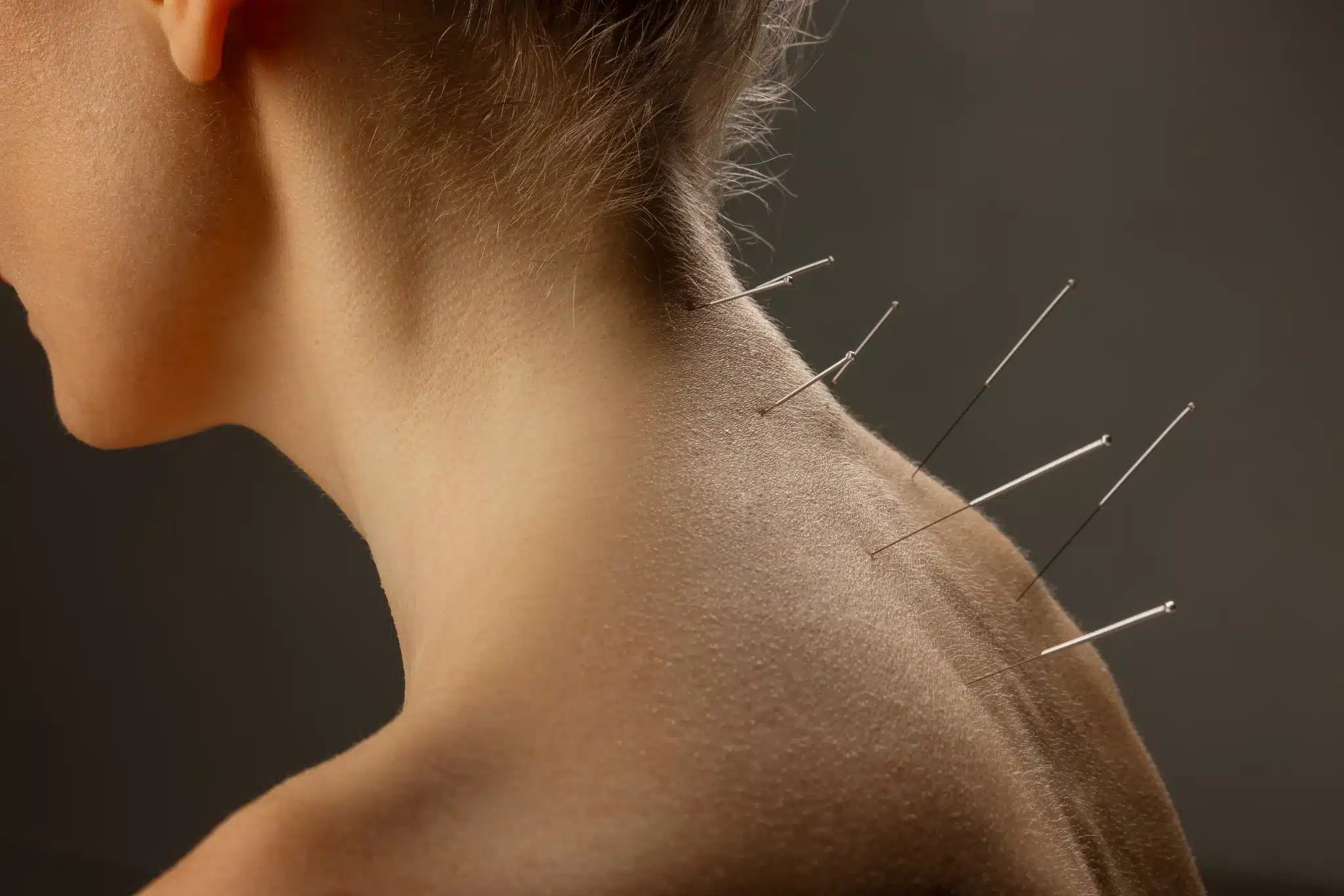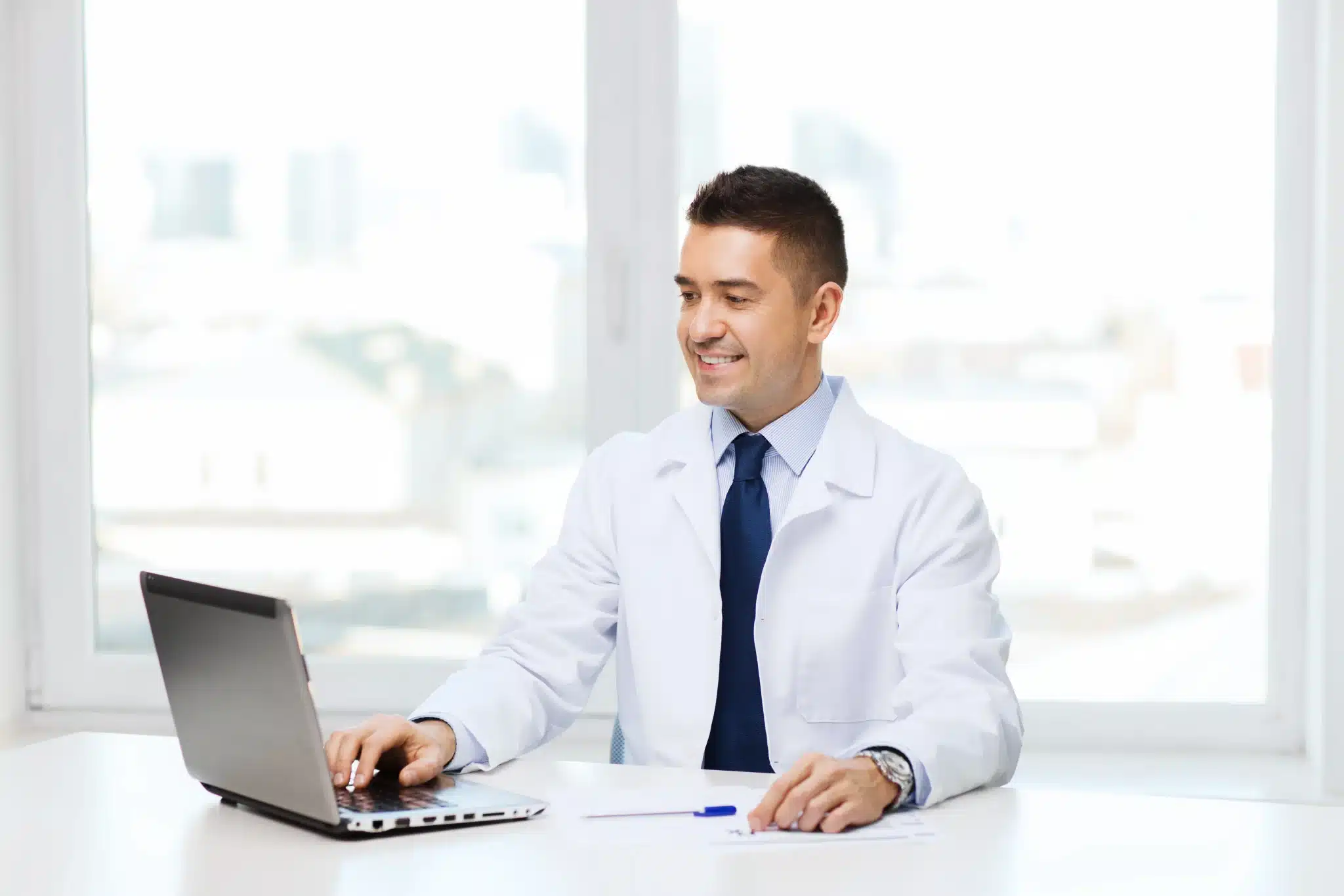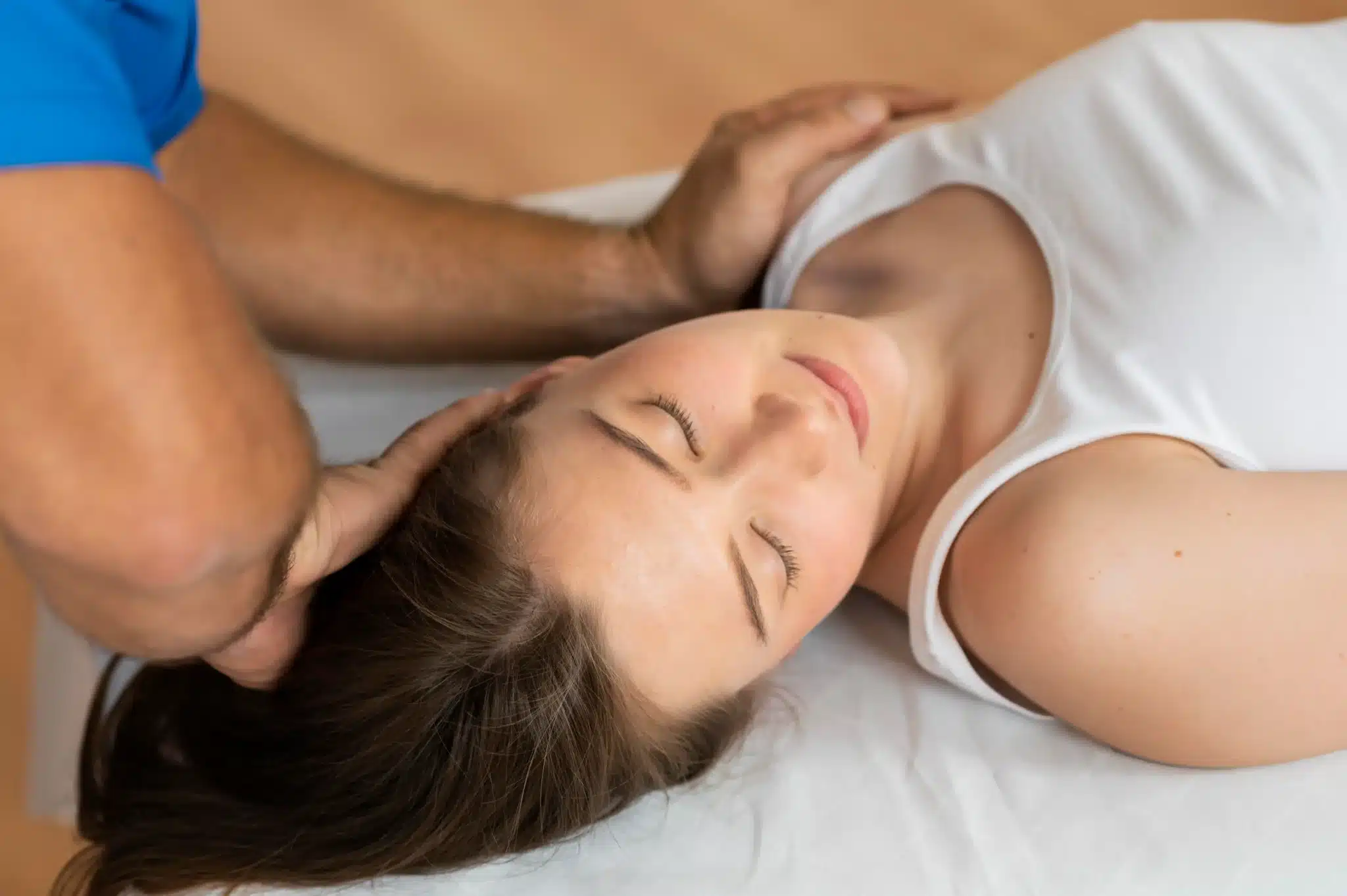Ever wondered why it hurts to stand up straight? You're not alone—lower back pain affects 84% of adults worldwide and can seriously impact quality of life if left untreated. Is your pain due to muscle strain, degenerative disc disease, or poor posture? Understanding the cause is crucial for effective relief
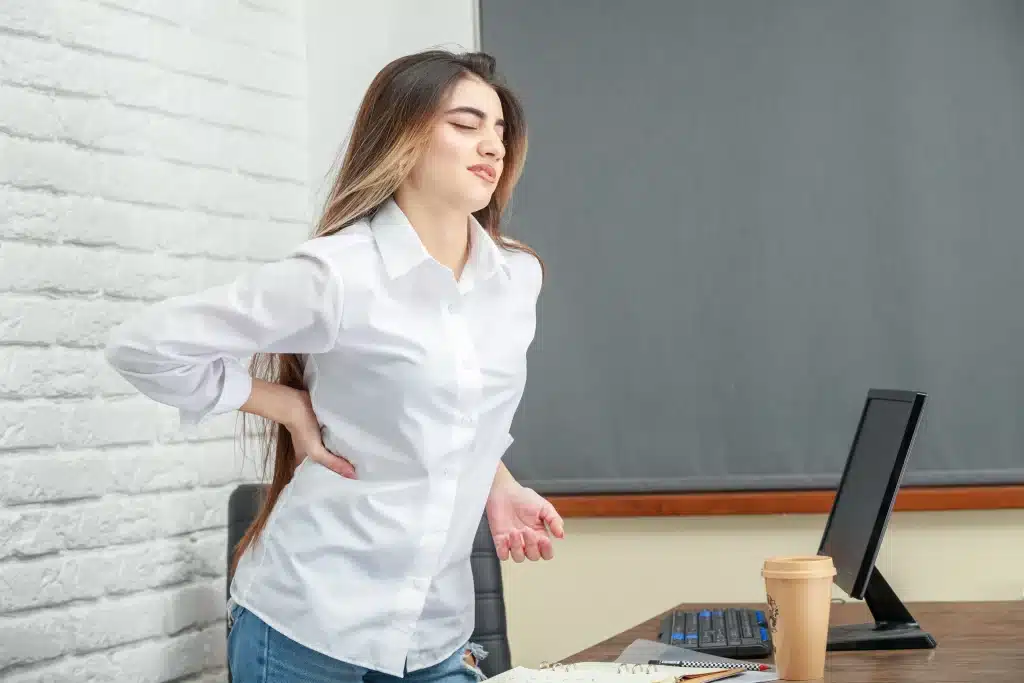
A detailed anatomical illustration of the human lower back, highlighting various structures such as muscles, ligaments, vertebrae, and nerves, with visual symbols representing common causes of lower back pain, like herniated discs, muscle strain, and sciatica. Include a gradient background to enhance the focus on the anatomy.
Key Takeaways
- Lower back pain is the second most common reason for doctor visits.
- Muscle strains or ligament sprains are reported as the cause in 70% of mechanical lower back pain cases.
- Conditions like degenerative disc disease, sciatica, and spinal stenosis are frequent culprits behind chronic lower back pain.
- Preventive measures like maintaining good posture, engaging in regular physical exercise, and using proper lifting techniques can help mitigate symptoms.
- Immediate medical attention is crucial if back pain is accompanied by severe symptoms like loss of bladder or bowel control or significant movement restriction.
- Using hot and cold packs alternately can help reduce pain, inflammation, and muscle spasms, thereby improving flexibility.
Muscle Strain or Ligament Sprain
Muscle strains and ligament sprains are common causes of lower back pain. They happen when you stand or do activities. These injuries need care to heal properly.
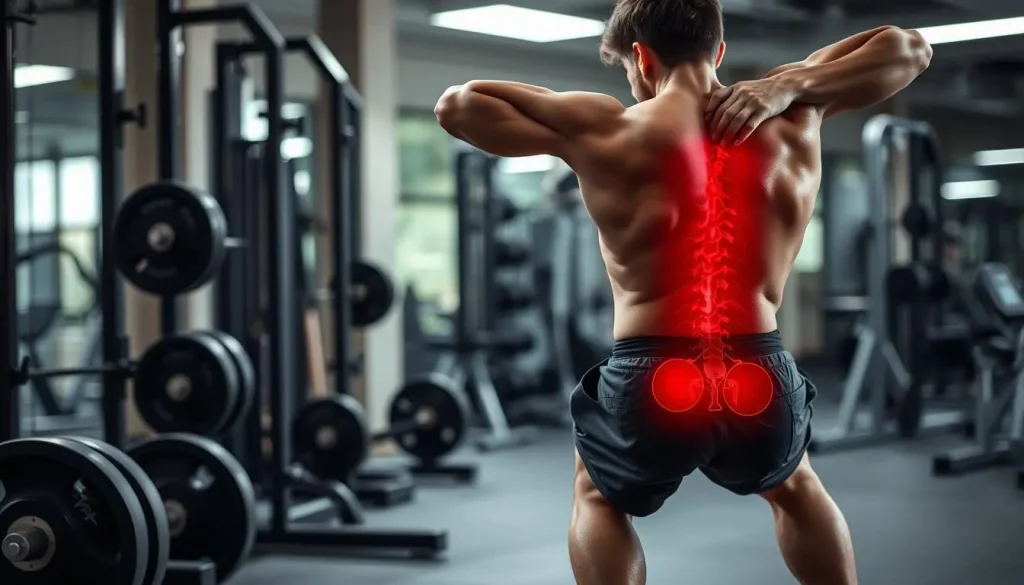
A person in a gym setting grimacing in discomfort while attempting to stand upright after performing squats, highlighting tension in the lower back area, with weights and exercise equipment nearby, focused on the posture and body language that conveys pain and strain, realistic anatomical details.
Injury
Acute injuries, like falls or sudden impacts, often cause lower back pain. If you feel pain after squats, check if it's a muscle strain or ligament sprain. M54.51 is a code for vertebrogenic low back pain, which can make moving hard and hurt a lot.
Poor Posture
Poor posture can lead to back problems over time. Sitting or standing wrong can stress your spine and muscles, causing pain. People often get vertebrogenic low back pain ICD 10 symptoms from this.
Correcting your posture and using ergonomic tools can help. Physical therapy is key for strengthening back muscles after strains.
Lifting Heavy Objects
Lifting heavy things can also hurt your back. Bad lifting techniques can stretch or tear muscles and ligaments. This requires a lot of care. Always lift right and use safety gear to avoid back pain.
Millions go to the doctor every year for these injuries. It shows how important it is to prevent them.
Degenerative Disc Disease
Degenerative Disc Disease (DDD) is a common condition where spinal discs wear down. This can cause a lot of vertebrogenic pain. As the discs get worse, they can't cushion the vertebrae as well. This makes it hard to move or stay active.
l
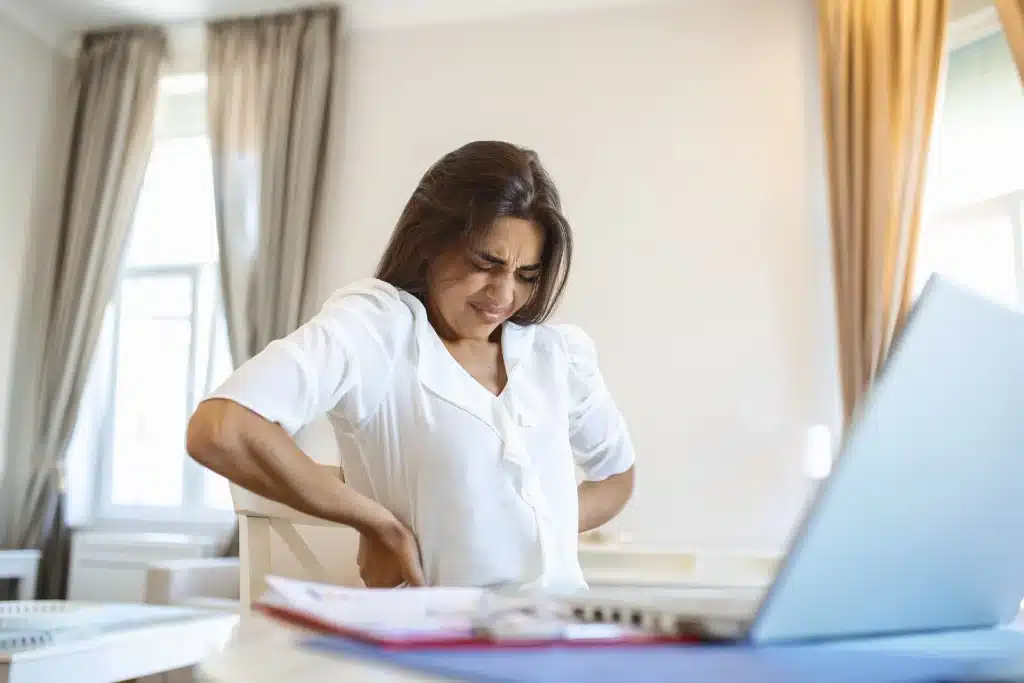
An abstract representation of vertebrogenic pain, featuring a stylized spine surrounded by vibrant, swirling colors emanating from the area of discomfort, with hints of anatomical structures and a soft, ethereal glow highlighting the tension and strain.
Symptoms
The symptoms of degenerative disc disease vary. People often feel pain in their buttocks and thighs. The back pain location chart can help figure out where the pain is.
In some cases, numbness or tingling in the legs happens. This can lead to intense lower back pain. It can even make it hard to stand up straight.
Treatment
There are many ways to treat degenerative disc disease. Doctors often suggest nonsteroidal anti-inflammatory drugs (NSAIDs) to reduce pain and inflammation. Physical therapy can also help by strengthening the muscles around the spine.
In severe cases, surgery like spinal fusion might be needed. This can relieve nerve pressure and stabilize the spine. For more on managing chronic pain and DDD, check out this resource.
Slipped Disc and Sciatica
A slipped disc happens when a disc in the spine bulges out. This puts pressure on nearby nerves. It often causes sciatica, which is pain in the lower back that gets worse when standing or sitting for a long time.
Common Symptoms
Pain that shoots down to the arm or leg is a common sign of a herniated disc. Men are more likely to get a herniated disc than women. Symptoms can also include numbness, tingling, or a burning feeling.
It's important to know the difference between a herniated disc and other conditions. This includes understanding the lower back pain differential diagnosis. Sciatica usually affects one leg and can cause sharp pain from the lower back to the buttock or leg.
Treatment and Management
First, doctors usually try non-surgical methods like rest, anti-inflammatory drugs, and physical therapy. These help reduce inflammation and ease pain. If these don't work, surgery might be needed to fix the slipped disc and relieve nerve pressure.
Doctors often use MRI to diagnose herniated discs. If you have severe symptoms like electric shock sensations, leg weakness, numb hands, or sharp pain when coughing or sneezing, get help right away. Accurate diagnosis is key to treating the right condition and avoiding confusion in the lower back pain differential diagnosis.
Many people say, "my lower back burns and hurts." But with the right diagnosis and treatment, they can feel better and go back to their normal lives.
Spinal Stenosis
Spinal stenosis is when the spinal canal gets narrower. This puts pressure on the spinal cord or nerves, causing pain and making it hard to move. It affects about 11% of adults in the U.S., with more cases in those over 60.
This condition mainly hits the lower back and neck. It's important to figure out if it's the cause of pain in these areas.
Causes and Symptoms
Things like arthritis, degenerative disc disease, and thickened ligaments can cause spinal stenosis. Bone spurs, herniated disks, and wear-and-tear from age also play a part. Symptoms include lower back pain, pain in the buttocks and legs, numbness, and tingling.
In severe cases, it can even affect bladder control. But, 80% of people over 60 with it don't show symptoms. So, diagnosing it is key.
Non-Surgical Treatments
For spinal stenosis, there are non-surgical ways to feel better. Physical therapy helps strengthen muscles and improve flexibility. Anti-inflammatory injections can also help by reducing nerve inflammation.
A team of healthcare providers might suggest a mix of these treatments based on what's best for you.
Surgical Procedures
When non-surgical methods don't work, surgery might be needed. Procedures like laminectomy or foraminotomy can widen the spinal canal. This helps relieve pressure on nerves.
Surgery is usually for those over 50, especially if they're not getting better with other treatments. Younger people with spinal deformities might also need surgery.
| Cause | Non-Surgical Treatment | Surgical Procedure |
|---|---|---|
| Arthritis in Facet Joints | Physical Therapy, Anti-inflammatory Injections | Laminectomy, Foraminotomy |
| Degenerative Disc Disease | Physical Therapy, Medication | Spinal Fusion, Disc Replacement |
| Thickened Ligaments | Stretching Exercises, Anti-inflammatory Injections | Laminectomy |
Spinal stenosis is complex, with many causes and treatments. Knowing about it helps manage it better. Getting a proper diagnosis from a healthcare professional is crucial.
Compression Fractures
Compression fractures are a common cause of severe back pain, especially among postmenopausal women and older adults. These fractures happen when bones in the spine become brittle and collapse. Over 700,000 Americans are affected each year, with osteoporosis being the main cause. Advanced age and osteoporosis are big risk factors, making it important to check bone health regularly.
Risk Factors
Osteoporosis is the biggest risk factor for compression fractures. It affects 25% of postmenopausal women over 50 and 40% of women by age 80. Other risks include advanced age, spinal tumors, and even minor actions like coughing or missteps. Tools like spinal X-rays, CT and MRI scans, and bone density exams help spot these fractures. People with compression fractures are at a higher risk of more fractures, showing why early action is key.
Treatment Options
Treatment for compression fractures often starts with conservative methods. This includes wearing supportive braces, managing pain with medications, and physical therapy. For severe cases, surgery like vertebroplasty or kyphoplasty might be needed. These surgeries use quick-setting cement to stabilize the spine. Cahaba Pain and Spine Care says kyphoplasty can help restore vertebral height and ease pain. Taking osteoporosis treatments like calcium and vitamin D supplements can also help prevent more fractures. Most compression fractures heal in 2 to 3 months, but ongoing care is needed to prevent them from happening again.
If you're experiencing my lower back burns and hurts or notice other symptoms that match a lower back pain location chart meaning, see your healthcare provider. They can give you an accurate diagnosis and the right care plan.
FAQ
What could cause lower back pain after squats?
Lower back pain after squats can be due to muscle strains or ligament sprains. It can also happen if you lift wrong or put too much weight on your back. Make sure to lift right and maybe do less weight or reps to feel better.
What is the ICD-10 code for vertebrogenic low back pain?
The ICD-10 code for vertebrogenic low back pain is M54.51. This code is for pain from the vertebrae in your lower back.
How can I differentiate between muscle strain, ligament sprain, and other lower back pain causes?
To figure out what's causing your lower back pain, look at your symptoms. Does the pain get worse when you move? Do you feel stiff or have muscle spasms? Knowing where the pain is can help too. A doctor or imaging tests can give you a clear answer.
What does it mean if my lower back burns and hurts?
If your lower back burns and hurts, it might mean your nerves or muscles are irritated. This could be from a slipped disc or sciatica. You should see a doctor to find out for sure and get the right treatment.
How do I use a lower back pain location chart?
A lower back pain location chart helps you find where your pain is coming from. It shows you different areas of pain and what might be causing them. This helps doctors figure out what's wrong and how to fix it.
What are some common causes of lower back pain besides muscle strain and ligament sprain?
Besides muscle and ligament issues, lower back pain can come from things like degenerative disc disease, slipped discs, spinal stenosis, and compression fractures. Each one has its own symptoms and treatments. It's best to talk to a doctor about what you're experiencing.
What treatments are effective for lumbar pain after squats?
Good treatments for lumbar pain after squats include resting, physical therapy, using heat or cold, and pain meds. It's also key to squat right and slowly increase how hard you're working out.
What symptoms may indicate degenerative disc disease?
Signs of degenerative disc disease include pain in your lower back that gets worse when you stand or sit for a long time. You might also feel pain in your buttocks and thighs, numbness or tingling in your legs, and sharp pain now and then.
What is the treatment for vertebrogenic pain?
For vertebrogenic pain, treatments might include NSAIDs for swelling, physical therapy to make your spine stronger, and sometimes surgery to take pressure off nerves.
What are the typical symptoms of a slipped disc?
A slipped disc usually causes sharp pain that goes to your buttocks or leg, numbness or tingling, and lower back pain that gets worse when you stand or sit for a long time.
How is sciatica treated and managed?
Sciatica treatment might include physical therapy, pain meds, and sometimes surgery to fix the slipped disc. It's also important to keep good posture and lift right.
What are the causes and symptoms of spinal stenosis?
Spinal stenosis happens when your spinal canal gets narrower. It can cause pain that feels better when you lean forward or sit. Symptoms include lower back pain, numbness, weakness, and trouble walking.
What are non-surgical treatments for spinal stenosis?
Non-surgical treatments for spinal stenosis include physical therapy to strengthen muscles, injections to reduce swelling, and pain meds to help you move better.
What surgical procedures are available for spinal stenosis?
For spinal stenosis, surgery might be needed to make your spinal canal bigger and relieve nerve pressure. This can include laminectomy or spinal fusion.
What factors increase the risk of compression fractures?
Older age, osteoporosis, and being postmenopausal can increase your risk of compression fractures. These conditions make your bones more likely to break.
What treatment options are available for compression fractures?
Treatments for compression fractures include wearing supportive braces, pain meds, and sometimes surgery like vertebroplasty or kyphoplasty to stabilize your spine.


